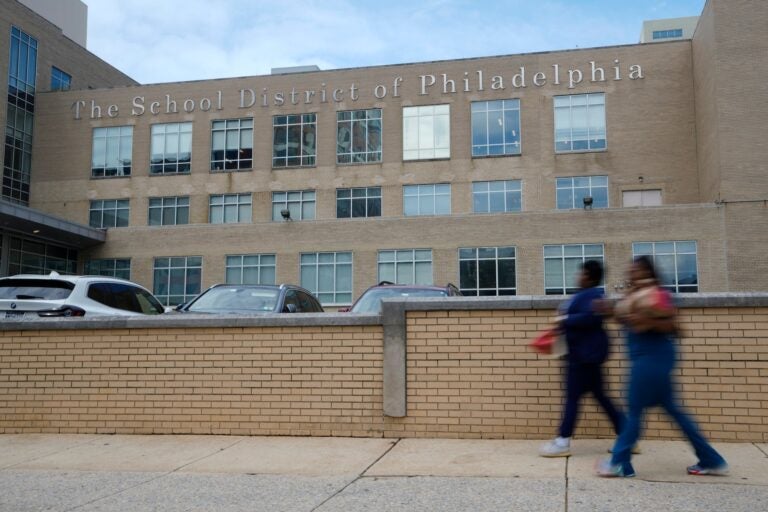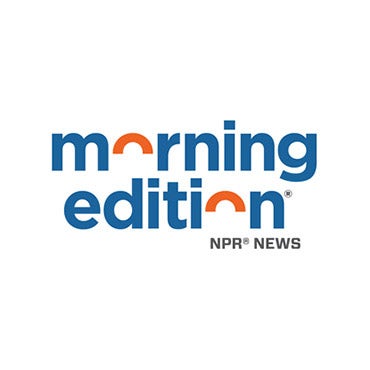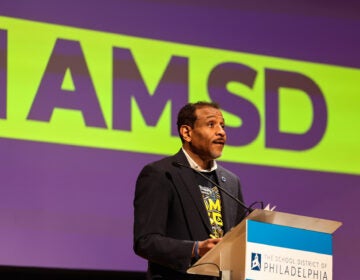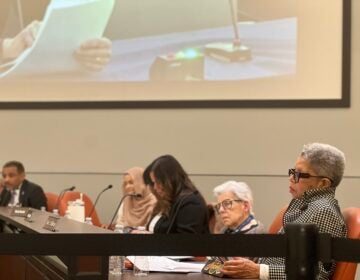School board talks ELA curriculum rollout at ‘Goals and Guardrails’ meeting
At a meeting to monitor the district’s academic progress, Philly’s school board reflected on the rollout of a new “science of reading” curriculum and other changes.

The School District of Philadelphia headquarters are shown in Philadelphia, Tuesday, July 23, 2024. (AP Photo/Matt Rourke)
From Philly and the Pa. suburbs to South Jersey and Delaware, what would you like WHYY News to cover? Let us know!
Philadelphia’s school board convened Thursday night for a “Goals and Guardrails” meeting, reflecting on the progress of its new English Language Arts curriculum. Six months into the rollout, student test scores have remained steady, aligning with pre-existing trends of gradual improvement.
Assessing the Impact
The district’s new ELA curriculum for kindergarten through eighth grade, developed by the nonprofit organization EL Education, is based on the “science of reading” approach, which emphasizes phonics and foundational literacy skills over contextual guessing. Before its adoption, Philadelphia teachers lacked a standardized method for teaching reading.
Though Philadelphia’s reading scores lag behind state and national averages, the district has seen more stability in its literacy rates than many large city school systems, some of which have continued to decline post-pandemic. By fourth grade, more than 65% of Philadelphia students still read below grade level, according to the Read by the 4th organization. However, according to district officials, the city’s schools are recovering from the pandemic faster than other large city school districts.
“This curriculum that we’ve implemented just this year — and we haven’t had a full year of implementation — it is already showing that it is continuing to make a difference,” Deputy Superintendent Jermaine Dawson told the board.
Dawson emphasized student improvement over the course of the school year, though it is virtually the same as it was last year: The increase in scores on Star ELA tests from fall to winter this year is proportional to the previous couple of years.
It’s too early to assess whether the new “science of reading” system is having an impact, according to Dr. Tonya Wolford, who serves as chief of district evaluation, research and accountability.
Still, she said, “We can say we are headed in the right direction.”
Board members also noted a trend of students entering school with slightly stronger reading skills each year, leading to incremental gains in later grades.
“What this is saying,” Dawson explained, “is that each year, we’re getting better at sending students to third grade who are in a better position to have the foundational skills that they need in order to demonstrate mastery.”
Implementation Challenges and Adjustments
To support teachers in executing the curriculum, the district provided three professional development sessions in August, October and January, each attended by more than 2,500 educators, according to school officials. Surveys showed an increase in teacher confidence, with 87% reporting they felt “prepared” to teach the curriculum in January, up from 72% in August.
However, teachers cited limited planning time as a challenge. In response, Superintendent Tony Watlington said the district had revised its ELA pacing guides to “provide additional flex time” based on teacher feedback.
The district also launched a pilot tutoring program in December as part of its five-year Accelerate Philly plan. With a $6.4 million contract for tutoring services, four elementary schools—Francis Scott Key, Mitchell, Roosevelt and Kenderton—began offering small-group ELA tutoring for K-3 students.
Currently, 279 students, about 45% of those schools’ populations, receive tutoring three times a week from 24 part-time instructors. The program will be evaluated later this year for potential expansion.
Wolford, Watlington and Dawson said that the “science of reading” curriculum will likely be more impactful for students the younger they are. The literacy building blocks are established in kindergarten, first and second grades, but third and fourth grade students will be able to “recoup that loss a little bit faster” than older students who are multiple years out from those foundational years.
“So for us, we’re having to be very intentional in two things,” Dawson said. “One, giving those students the specific foundational skills, and also helping our high school teachers support this.”
Support for English Learners and Students with Disabilities
Dawson and other district leaders acknowledged the need for targeted strategies to support students learning English as a second language and those with Individualized Education Plans.
Board member Wanda Novalés pressed Dawson for specifics.
“Dr. Dawson, during the presentation, you used the phrase ‘more intentional’ four to five times,” she noted. “Specifically with [English language learners]. Which made me think, what does that mean? What does that look like in our classrooms?”
Watlington responded with an anecdote about visiting a classroom where an ELL student appeared disengaged. He and Dawson reviewed school records to see if any peers spoke the same first language and explored using digital translation tools, such as Google Translate, to support communication.
“When I go out of the country, I’ll pick up my phone, I’ll say something to my phone, and it’ll translate,” Watlington said. “I mean, there’s some technologies we can use. That’s one example of being more intentional. Not the best, but one.”
“So, hopefully, I’ll get some more information,” Novalés said, nodding.
As the district continues refining its approach, board members and administrators stressed the importance of monitoring the curriculum’s long-term impact and making necessary adjustments to better support teachers and students alike.

Get daily updates from WHYY News!
WHYY is your source for fact-based, in-depth journalism and information. As a nonprofit organization, we rely on financial support from readers like you. Please give today.






